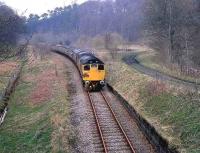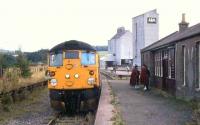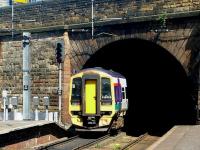This day in history 07 May
Images
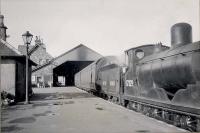
Kirkcudbright: Kirkcudbright. C.R. 0.6.0 57329 on branch train.
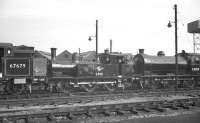
Darlington Shed: A trio of locomotives fresh from a works visit standing in the yard alongside Darlington shed, thought to have been in May 1960. Left to right are V3 67679, J72 69011 and J27 65819. The locomotives would be returning to Glasgow, Hull and Blyth respectively
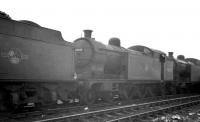
Darlington Shed: Death row. Withdrawn steam locomotives in a holding siding alongside Darlington shed in May 1960, pending transfer to the nearby works scapyard. Those awaiting their fate include A8 Pacific tank 69858, recently arrived from Sunderland South Dock and cut up a few days later.

Bowhouse: Pickersgill 3P 4-4-0 no 54465 stands at Bowhouse (closed to passengers 1930) on Saturday 7 May 1960 with a pair of ex-Caledonian coaches on an SLS rail tour which started and finished at Polmont.

Darlington Shed: Immaculate looking B16 4-6-0 no 61429 of Leeds Neville Hill standing in the sidings at Darlington shed in May 1960.

Carlisle: J21 0-6-0 no 65033 stands at Carlisle platform 4 on 7 May 1960 with the R.C.T.S. (N.E. Branch)/Stockton & Darlington Locomotive Society J21 Rail Tour. According to the station clock, the special is already 5 minutes down on its scheduled 4.30pm departure time for the return trip to Darlington via Penrith, Appleby East and the Stainmore route.
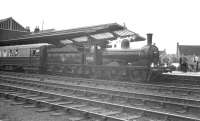
Barnard Castle: 65033 stands at the platform at Barnard Castle on 7 May 1960 at the head of three Gresley teak-bodied coaches forming the joint RCTS (NE Branch)/Stockton & Darlington Locomotive Society J21 Railtour see image [[32382]].
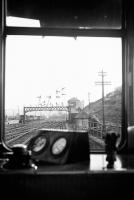
Ferryhill Junction: View from rear of BMU approaching Aberdeen station, having just passed Ferryhill Junction signal box (7th May 1960). The right-hand side of the cab can be seen with the brake valve and brake gauges.

Grangemouth: 54465 stands at Grangemouth with the BLS rail tour originating from Polmont on 7 May 1960

Kirkby Stephen East: 65033 with the joint RCTS (N.E. Branch)/Stockton & Darlington Locomotive Society J21 Rail Tour at Kirkby Stephen East on 7 May 1960. The locomotive is standing below the A685 road bridge prior to heading back to Darlington via Stainmore.
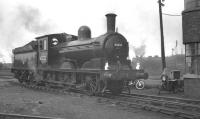
Darlington Shed: Smart looking class J21 0-6-0 no 65033 photographed alongside the shedmaster's office at Darlington. The occasion is the RCTS/S&DLS J21 Railtour of 7 May 1960 involving a return trip to Carlisle via the Stainmore route.
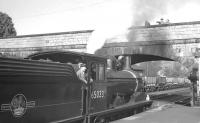
Kirkby Stephen East: J21 0-6-0 no 65033 with the RCTS/Stockton & Darlington Locomotive Society J21 Rail Tour at Kirkby Stephen East on 7 May 1960. The special was returning from Carlisle to Darlington via the Stainmore Route.

Bonnybridge [CR]: 54465 photographed at Bonnybridge after arriving with a BLS rail tour from Polmont on 7 May 1960. The former Caledonian terminus on the canal branch from Greenhill Lower Junction had been closed to passenger traffic since 1930 and was eventually closed completely in 1964.

Bo'ness [1st]: 54465 at Bo'ness during the Branch Line Society rail tour from Polmont on 7 May 1960. The pair of ex-Caledonian coaches used on the tour can be seen in the background.
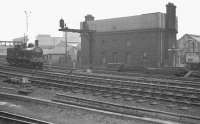
Newcastle Central: J21 0-6-0 65033 about to run past the 1891 LNER water tower at Newcastle Central on 7 May 1960. The locomotive (which pre-dates the water tower by two years) was heading for Darlington to pick up the RCTS/SDLS J21 Rail Tour (also referred to as the Stainmore Special) see image [[36091]].

Polmont: A4 Pacific no 60011 Empire of India hauling a train destined for Glasgow Queen Street arrives at Polmont in May 1960 propelling a failed Swindon InterCity DMU. The bay used by Bo'ness branch services is on the left.

Smardale Gill Viaduct: Photograph taken from the the R.C.T.S. (N.E. Branch) / Stockton & Darlington Locomotive Society J21 rail tour of 7 May 1960. The location is Smardale Gill Viaduct on the Kirkby Stephen to Tebay section.

Barnard Castle: 65033 takes water at Barnard Castle on 7 May 1960 during a stop on the RCTS J21 railtour.
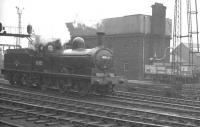
Newcastle Central: Heading for Darlington. Worsdell NER 1889 veteran (BR class J21) 0-6-0 65033 passing Newcastle Central on its way to Darlington on 7 May 1960. From there it would later work the RCTS/SDLS Stainmore Special (or 'J21 Rail Tour') to Carlisle and back see image [[32382]].

Bo'ness: Pickersgill 4-4-0 no 54465 getting ready to leave Bo'ness and head for Bowhouse with the next leg of the BLS railtour of 7 May 1960 see image [[25421]].
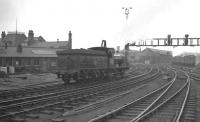
Newcastle West Junction: Well turned out J21 0-6-0 65033 takes the goods lines past Newcastle Central heading for the King Edward Bridge early one grey Saturday morning in May 1960. The 1889 locomotive was on its way from Heaton to Darlington where it would take charge of the SLS/SDLS J21 Rail Tour to Carlisle via Stainmore. See image [[36451]]
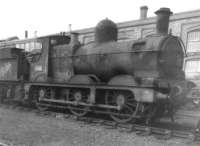
Swindon Works: GWR Dean Goods 0-6-0 no 2516, built at Swindon in 1897, seen outside the Works in 1961 awaiting restoration to prepare for display in the then Swindon Railway Museum, housed in a former chapel building.

Swindon Works: 'Warship' diesel hydraulic no D829 Magpie at Swindon Works in May 1961.

Swindon Works: North British built diesel hydraulics D6303 and Warship D835 Pegasus standing together outside Swindon Works on 7 May 1961.
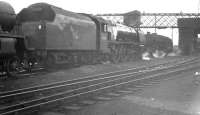
Carlisle Upperby Shed: Stanier Coronation Pacific 46253 City of St Albans stands in the shed yard at Upperby in the summer of 1962. The locomotive was a visitor from Crewe North, from where it was withdrawn in January the following year.
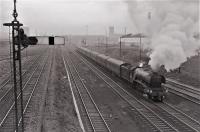
Germiston Junction High: A3 Pacific 60094 'Colorado' brings the 1.15pm Glasgow-Dundee past Germiston High junction on 7th May 1963.
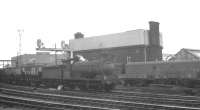
Newcastle Central: Sunderland based J27 0-6-0 no 65872 brings an up train of mineral wagons off the High Level Bridge and along the south side of Newcastle Central on the goods lines in May 1966.

Gateshead: BR Standard class 9F 2-10-0 no 92064 with an eastbound freight running alongside Gateshead shed between King Edward Bridge and Greensfield Junction in May 1966.

Rosewell and Hawthornden: Desolation at Rosewell and Hawthornden looking north towards Hardengreen Junction in 1970. The station had closed to passengers in 1962 with the last freight (off the Penicuik branch) having passed through in April 1967. Level crossing gates still stand in the background beyond the platforms.
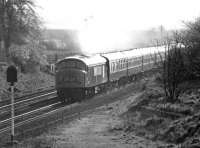
Inveresk: The early evening sun catches Holbeck 'Peak' 190 as it runs past the site of Inveresk goods yard with the 17.10 Edinburgh - Leeds service on 7 May 1970. In the background above the train are the semaphores controlling the freight-only line to Smeaton which has diverged from the ECML at the original Monktonhall Junction, just off picture to the right.
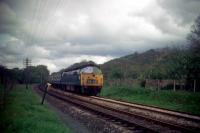
Respryn: 1012 'Western Frirebrand' working 1B15 1030 Paddington to Penzance, passing Respryn just south of Bodmin Road, on Sunday, 7 May 1972.

Alness: Bunting in evidence as a Class 24-hauled train for Inverness calls at Alness on the first day of service following the station's re-opening in May 1973. Sadly, the attractive Highland Railway station building has since been demolished.

Alness: Here comes the train... and only 13 years late! An expectant crowd spots the class 24-hauled service from Inverness as it approaches Alness for the official reopening ceremony on 7 May 1973. The station had closed in 1960 when pre-Beeching cuts eliminated a swathe of wayside stations on the Far North line.

Alness: The official re-opening train (the normal mid-morning Inverness-Wick service) pulls into Alness station in May 1973. The man with the camera is Adrian Varwell, local representative of the Scottish Association for Public Transport, who played a big part in the re-opening campaign.

Ferryhill Junction: An unidentified Class 26 heads south at Ferryhill Jct with a parcels train in the evening of 07 May 1975
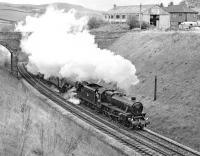
Rowe Head: Preserved Black 5 No. 45407 and A3 Flying Scotsman dig in on the ascent of Lindal Bank, while working a railtour between Carnforth and Sellafield in May 1977. Taken at Rowe Head, about a mile and a half west of Ulverston.
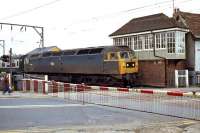
Colchester: A very shabby 47 165 heads a returning excursion that has spent the day at Clacton on Bank Holiday Monday, May 7th 1979. It is seen passing East Gate Junction signal box in Colchester, which remained in operation for another 30 years before it was closed as part of a signalling modernisation scheme.
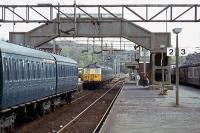
Thorpe le Soken: In 1979, trains were still combined or divided at Thorpe le Soken for the London - Clacton/Walton services. A division has just occurred at platform 1 and the front unit is heading off to Walton. Today, platform 1 has no track to serve it.

South Shields [NER]: A Cravens DMU waits under the overall roof at South Shields on 7 May 1981 with a return service to Newcastle Central. The old station closed 24 days later.

Slateford: 47458 takes a train east through Slateford station heading for Waverley in the spring of 1981.
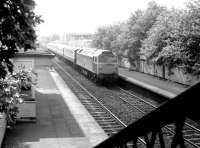
Slateford: A class 47 hauled train passing east through Slateford station on its way to Waverley in May 1981, prior to demolition of the old station buildings. The train is the Edinburgh portion of a down WCML service which had been split at Carstairs.
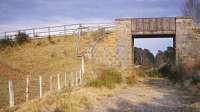
Nethy Bridge: A GNSR overbridge near Nethy Bridge, on the south side heading to the River Spey.
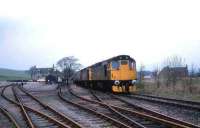
Dufftown: Special ready to leave Dufftown in May 1983 behind 27002+27003.

Cranmore: Dubs 0-4-0CT Crane Tank (4101/1901) at work on the East Somerset Railway on 7 May 1983.
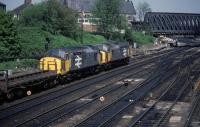
Holgate Junction: 37511 and 37506 on Corby to Lackenby steel empties at York Holgate in May 1987. Often the empty northbound and loaded southbound services would pass here.
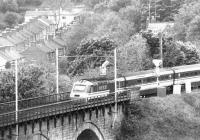
Durham: A down BR InterCity 125 service crosses Durham Viaduct northbound in the spring of 1992.
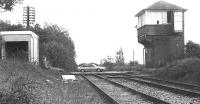
Usworth: The site of Usworth station on the old main line through County Durham via Leamside in May 1992. View is north towards Pelaw Junction over the former A1290 level crossing.
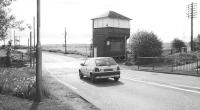
Usworth: A vehicle heading east towards Sunderland about to pass over the out-of-use level crossing at Usworth, County Durham in 1992. Located on the Leamside line between Pelaw Junction and Washington, the station (which stood off to the right) closed to passengers in 1963. [Ref query 9490]

Glenesk Viaduct: View over the graceful Glenesk Viaduct, some 6 miles from Edinburgh, looking south in 2002. The split of the Waverley route and the line to Dalkeith occurred at Glenesk Junction on the far side. The viaduct was built by the Edinburgh and Dalkeith Railway and dates from 1830. see image [[39780]].
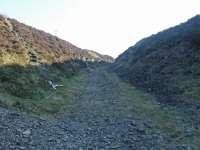
Glengonnar: View looking to Wanlockhead from Glengonnar station in May 2003. The buffer is behind the camera.
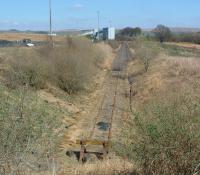
Knockshinnoch Washery: Knockshinnoch Washery seen from the buffer end of the line in 2003.

Haymarket: Looking west from Haymarket station in May 2004. In the right background are the south stand of Murrayfield stadium and Haymarket MPD.

Haymarket: A GNER Glasgow Central - Kings Cross train entering Haymarket Tunnel on 7 May 2004.
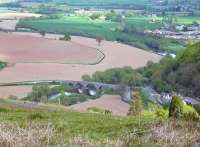
Kerne Bridge: View north of Kerne Bridge in July 2005. The Ross and Monmouth Railway followed the river before skirting the sawmills and Walford church (where Walford Halt was situated).

Larkhall Central: Larkhall looking north over the station site.

Larkhall Central: Drainage and works at the north end of Larkhall Station.
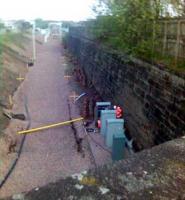
Larkhall Central: Looking north towards Merryton at Larkhall.
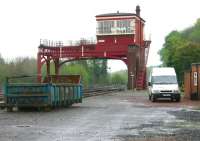
Hexham: The North Eastern Railway grade II listed signal box to the east of Hexham station, dating from 1897. View towards Newcastle in May 2006 from the site of the old goods yard.
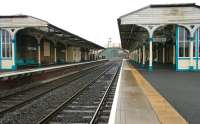
Hexham: Hexham looking east through the station in May 2006.
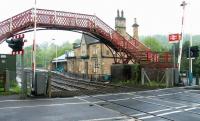
Wylam: Often referred to as '...one of the oldest railway stations in the world still in constant use', Wylam was opened in March 1835 by the Newcastle and Carlisle Railway. The photograph was taken on a dull and drizzly Sunday morning in 2006 looking east over the level crossing towards Blaydon.
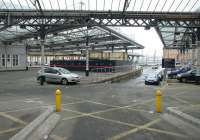
Newcastle Central: Looking through the arched entrance from Neville Street into the former goods and parcels area at the west end of Newcastle Central in 2006.

Newcastle Central: 100 years on. The former NER parcels depot of 1906 stands in Westgate Road alongside the east end of Newcastle Central in 2006, with all windows now boarded up. When operational the building was accessible at both road and platform levels see image [[21815]].
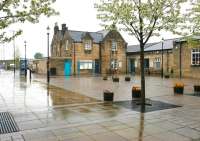
Hexham: Looking across the station forecourt at Hexham on a grey, wet day in May 2006. Still an attractive station nonetheless.
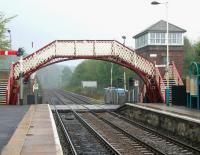
Prudhoe: A misty morning in the Tyne Valley at Prudhoe on 7 May 2006. Platform view west over Station Road level crossing, looking towards Hexham and Carlisle.
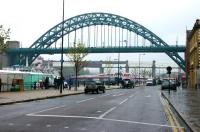
Newcastle Quayside Goods: Sunday morning on a grey and wet Quayside in May 2006. The Tyne Bridge dominates, with the red and white Swing Bridge beyond. Partially clad in white for maintenance is the High Level Bridge, with the Tyne & Wear Metro Bridge visible through the piers. The King Edward Bridge stands beyond. The Quayside branch, once operated by Gresley's two class ES1 electric locomotives, arrived from Trafalgar Yard via a tunnel behind the camera. The branch closed in 1969 see image [[20118]].
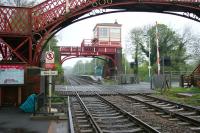
Wylam: Platform view east over the level crossing at Wylam from the staggered westbound platform in May 2006.
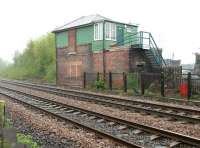
Blaydon East Junction: Looking north towards Blaydon signal box in May 2006. The box is angled towards the trackbed of the line that once turned off here to cross Scotswood Viaduct and take the North Tyne route into Newcastle. See image [[38015]]
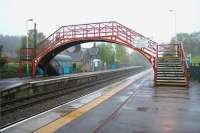
Riding Mill: Sunday morning at Riding Mill. Platform view west towards Carlisle through the station footbridge on 7 May 2006.
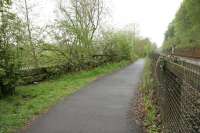
Border Counties Junction: A mile west along the Tyne from Hexham station is the site of Border Counties Junction. Here the Carlisle line continues west while the trackbed of the former Border Counties line begins to turn north towards the river (left) which it crossed en route to Riccarton see image [[9347]]. The south supporting wall of the signal box that straddled the line can be seen built into the cutting in the right background.
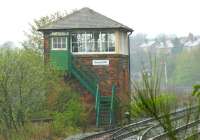
Bardon Mill: A switched-out Bardon Mill signal box on Sunday 7 May 2006, looking west towards Carlisle.
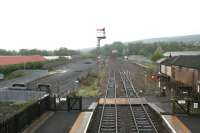
Hexham: Looking east from the station footbridge at Hexham on a damp and overcast day in May 2006. The former goods yard stood on the right, with the small 2-road engine shed (closed April 1959) located at the far end.
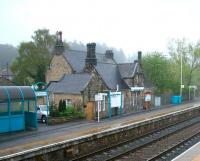
Riding Mill: The attractive station building at Riding Mill, Northumberland, opened by the Newcastle and Carlisle Railway in 1835. View is west from the footbridge on a damp and misty May morning in 2006.

Newcastle Central: The imposing station portico at Newcastle Central. 2006.
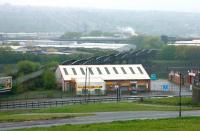
Scotswood Viaduct: Photograph taken from the high ground on the north bank of the Tyne at Scotswood on a Sunday morning in May 2006. View is south over Scotswood Road towards the old N&C railway bridge. On the far side of the river is part of the Blaydon industrial area with terraced streets visible just beyond through the morning mist.

Bardon Mill: Looking along the platform at Bardon Mill station, Northumberland, on Sunday morning 7 May 2006. View is east towards Hexham.
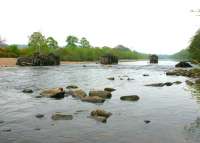
Tyne Viaduct [Border Counties]: The remains of the Border Counties Railway bridge over the Tyne in May 2006 looking east along the river towards Hexham. The site of Border Counties Junction on the Newcastle - Carlisle line is off picture to the right.
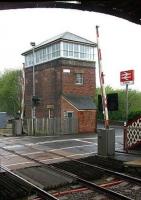
Prudhoe: The tall signal box at Prudhoe on the Newcastle and Carlisle line in May 2006. Photographed from the platform looking west below the footbridge over Station Road level crossing towards Hexham.
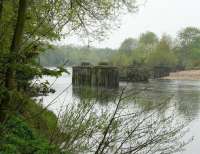
Tyne Viaduct [Border Counties]: A misty morning on the Tyne a mile west of Hexham station in May 2006. The photograph is taken looking north from alongside the site of Border Counties Junction on the Newcastle - Carlisle route see image [[9290]] and shows the remains of the bridge that took the Border Counties Line across the river at the start of its journey north to Riccarton Junction.
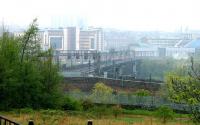
King Edward Bridge East Junction: Looking north across the Tyne through the early morning mist hanging over the river on Sunday 7 May 2006. In the foreground is King Edward Bridge East Junction and just off to the right was the entrance to Gateshead shed.
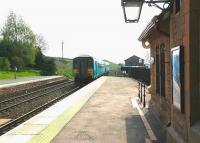
Langwathby: Platform scene at Langwathby on the Settle & Carlisle route on a pleasant May afternoon in 2006. A Northern DMU is approaching from the south with a Leeds to Carlisle service. The station building houses the 'Brief Encounter' cafe, while the old railway goods shed in the background is now used by a local road transport company.

Wylam: View east along the staggered platforms at Wylam, on the Newcastle & Carlisle line, looking over Station Road level crossing on a Sunday morning in May 2006. There has been a station here since March 1835. Wylam is claimed by many to be ...'the oldest railway station in the world, with original buildings, still in constant use'.
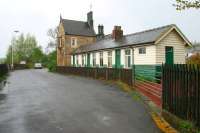
Bardon Mill: Standing in the rain at the exit from the eastbound platform (behind the camera) at Bardon Mill station on Sunday morning 7 May 2006. Ahead lies Station Road with the former station buildings and station master's house.
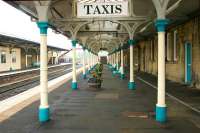
Hexham: View along the westbound platform at Hexham in May 2006.
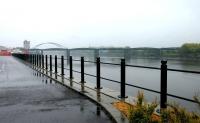
Scotswood Viaduct: What a grey day... View east along the Tyne at Scotswood on a wet Sunday morning in May 2006. The 700ft long Scotswood rail bridge crosses the river in the middle distance with the steel arch of the road bridge visible beyond. The rail bridge, the fourth on this site, dates from 1871. It once brought the Newcastle and Carlisle Railway from Blaydon into Newcastle via the north bank of the River Tyne. Closure took place in 1982. The bridge now carries water and gas mains. See image [[9338]] Just beyond the road bridge stood the Scotswood works of Armstrong Whitworth, where 1,464 locomotives were built between 1915 and 1937, including 327 Black 5s for the LMS.
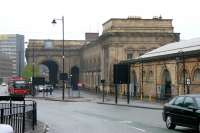
Newcastle Central: Newcastle Central looking down Neville Street in 2006. The arched entrances on the right gave access to goods, parcels and other facilities on the west side of the station.
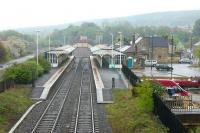
Hexham: View east over Hexham station from the A6079 road bridge in May 2006.
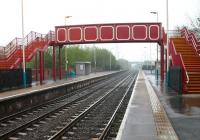
Blaydon: A wet Sunday morning in May 2006 looking east along the platforms at Blaydon station. The outline of Blaydon signal box can just be seen in the background between the signal and the road bridge. This was the point where the old main line turned north to cross the Tyne on Scotswood Viaduct see image [[9261]].
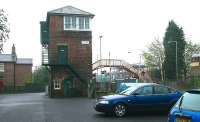
Prudhoe: The impressive looking signal box at Prudhoe, Northumberland, on a damp and overcast morning in May 2006. View is east towards Newcastle from the station car park, with the platforms beyond the level crossing.
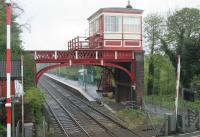
Wylam: The notable signal box at Wylam on the morning of 7 May 2006. Photographed from the station footbridge looking west towards Hexham.

Chinley North Junction: Central Trains liveried 170631 heads east at Chinley North Junction on 7 May 2007.

Pollokshaws West: Platform 1 waiting rooms buildings at Pollokshaws West. Taken from a passing train

Kennishead: 156506 departing Kennishead heading for Barrhead

Newburgh: 170401 the first turbostar heads east through Grange of Lindores. 1305 Perth to Glasgow diverted via Ladybank.
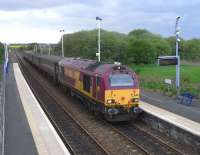
Cardenden: 67 003 arrives at Cardenden on 7 May 2009 with the evening EWS-stocked Fife Outer Circle service.

Carrog: Concrete sleepers can be seen laid out heading west, on the Llangollen Railway's extension towards Corwen, approx 1.0 Km beyond Carrog station, showing the line's juxta position with both the A5 trunk road and the lower River Dee at this location. A formal application was submitted recently to allow the railway to extend track through to a new station in Corwen sited by the main car park in the village.
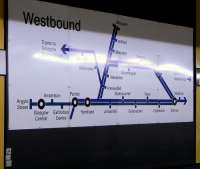
Argyle Street: The large line diagrams on the westbound sides of Argyle Street and Glasgow Central Low Level are 'back to front', with west on the right, in order to suit the direction of travel. Shouldn't they then also be upside down? Maybe I think about these things too much.... photographed on 7 May 2009.

Lancaster (Quayside): At its southern end Carlisle Bridge also carries the West Coast Main Line across St. Georges Quay in Lancaster where, until 1969, railway sidings served the various mills and factories. These sidings were accessed from Lancaster Castle station via the steeply graded Glasson Dock branch. View westwards as a Virgin Pendolino crosses the bridge.
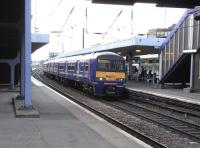
Haymarket: 322 484 at Haymarket with a North Berwick service on 7 May 2009.
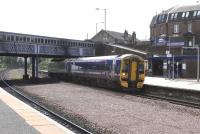
Larbert: 158 709 calls at Larbert with a Glasgow to Dunblane service on 7 May. In the other direction the Larbert Junction signal is set for the Edinburgh line.

Lenzie: An Alloa - Glasgow Queen Streeet service calls at Lenzie on 7 May. Unit 170 458.

Corwen [1st]: Former railway goods shed still in use alongside A5 trunk road to west of Corwen Station, with one loading door stoned up and full height roller shutter door fitted at far end.

Corwen [1st]: The former Corwen Station, with the station building now the sales office of Ifor Williams Trailers. The platform & trackbed area are used to display new trailers and provide servicing & spares facilities. Note the large glass frontage to the former entrance / waiting area through the centre of the building.

Corwen: A short distance east of the former Corwen GWR station the route of the former line branching off to Ruthin can be seen curving off to the left along the tree line, before crossing the River Dee, with the main line that continued to Ruabon running straight ahead. The new Corwen Station, currently being built on the Ruabon line trackbed by the Llangollen Railway, lies across the junction of the two former lines, with the headshunt ending just out of view to the right before the removed bridge over Y Lon Las / Green Lane. An access road leading to a new sewage treatment plant now runs between the large tree and the trackside fence and cuts thro' the former Ruabon line trackbed.

Lancaster: Carlisle Bridge, Lancaster, carrying the West Coast Main Line over the River Lune and seen here at High Tide from St. Georges Quay on the south side. The bridge was substantially rebuilt in the 1960s and a footbridge added to the east side as seen here. The southbound Pendolino is slowing for the Lancaster stop. The old Morecambe to Lancaster Green Ayre line passed under an arch of this bridge on the far bank.
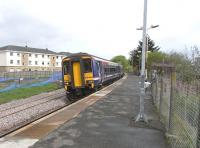
Stewarton: 156 449 about to leave Stewarton with a Glasgow - Kilmarnock service on 7 May 2009. The redoubled track is already in place here, as it is right back to Lugton, in readiness for the planned twice-hourly service on the line from December 2009. At Dunlop the second platform is substantially complete with even platform lighting in place, but here work has barely started. However, a white-tiled subway to the platform has recently been re-exposed.

Larbert: 170 476 emerges from the triple bridge at Larbert on 7 May with an Alloa - Glasgow Queen Street service.

Maryhill Central Junction: Looking north east across the River Kelvin towards the site of Maryhill Central Junction and Maryhill Central station beyond. View is over the remains of the Lanarkshire and Dumbartonshire viaduct with the Glasgow Central Railway's viaduct standing alongside to the east. Photographed on 7 May 2011. See image [[10342]] for the same view 53 years earlier.

Whixley: The ground frame now located in the garden shed at Whixley level crossing on the Harrogate - York line see image [[34061]] photographed in May 2011. Levers are (left to right), Down Distant, Up Distant and Crossing Gate Locking.

Maryhill Central Junction: Looking south over the former Glasgow Central Railway viaduct spanning the River Kelvin in May 2011. Kirklee station (closed in May 1939) stood a little way beyond the far end of the viaduct.
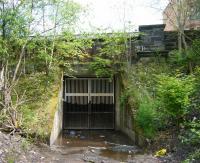
Maryhill Central: All that remains of the Glasgow Central Railway tunnel under Garrioch Road (now partially infilled) in May 2011. The tunnel once gave access to Maryhill Central station, closed to passengers in October 1964. See image [[10336]]

Whixley Level Crossing: The manned and gated level crossing at Whixley, sited approximately 1.4km west of Cattal station on the Harrogate to York line. The road is the single track Scate Moor Lane, running north easterly between the old A1 north of Walshford and the A59 south of Whixley village. The former open ground frame is now housed in the garden shed to the left of the gate. Photographed in July 2011. See image [[34083]]
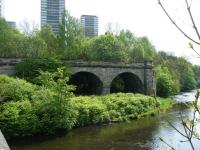
Dawsholm Viaduct: Part of the former Glasgow Central Railway viaduct over the River Kelvin, seen looking east from Kelvindale Road in May 2011. To the left was Dawsholm, which lost its passenger service as long ago as 1908 but remained open to goods traffic for a further 60 years. The former GCR route to Bellshaugh Junction headed off to the right.

Castlerock: Platform scene at Castlerock, Co Londonderry, on 7 May 2011. Note the somersault signal.

Maryhill Central Junction: The former Lanarkshire & Dumbartonshire Railway viaduct seen looking south over the River Kelvin on 7 May 2011. Part of the adjacent viaduct built by the Glasgow Central Railway can be seen through the gap between the piers.
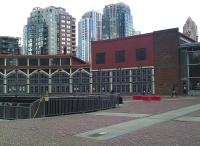
Vancouver: The original CPR Drake Street roundhouse, Vancouver, in May 2012. The photograph shows part of the main building with the turntable still intact in the centre.

Lindau: The early afternoon Zürich to München Euro-City express has left Lindau Hbf on 7 May 2013, allowing the release of ÖBB electric No 1144 105, which had brought the train in from Bregenz. It will be six years at least before the DB main line to München is electrified, so Lindau will continue to see a significant amount of diesel haulage for some time to come.

Yorkhill Quay: The cranes of the Govan shipyards are silhouetted by the evening sun on 7 May 2013. View west from Yorkhill Quay with Glasgow's Riverside Museum in the right background.
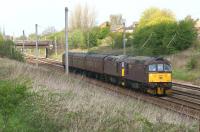
Farington Curve Junction: Seeing a Class 33 on the main line is fairly rare these days but two together is a special event. WCRC 33207 and 33029 head south of Farington Curve Jct on the WCML with the 5Z42 Carnforth to Southall ecs move on 7 May 2013.
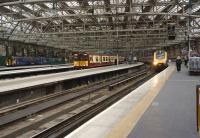
Glasgow Central: At around 1830 on a weekday evening Glasgow Central looks remarkably quiet under the big roof with only a Class 156, a 313, a Voyager and, hiding on the right, a Pendolino.
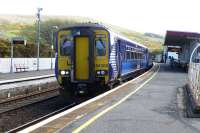
Girvan: The 14.33 to Glasgow Central via Kilmarnock awaiting its departure time at Girvan on 7 May 2015. Arrival in Central is 16.33, or get off at Ayr at 15.18 and catch the 15.24 via Paisley and arrive at 16.13.
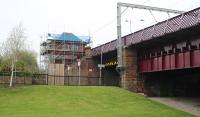
Coatbridge Central: Picture taken from street level, showing ongoing building work at Coatbridge Central. Taken on the 7th of May 2016. See image [[13706]]
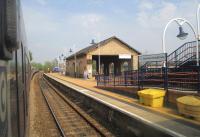
Mansfield Woodhouse: UK Railtours excursion from London St. Pancras to Cleethorpes passing Mansfield Woodhouse station, Nottinghamshire, on 7th May 2016. This line and station were closed as part of the Beeching cuts in 1964, rendering Mansfield as 'the largest town in England without a station' for many years. Reopening as far as Mansfield came in 1995 and was extended to Worksop, which saw Mansfield Woodhouse reopened, in 1998. Should never have closed in the first place - like many other lines in the UK. [Ref query 29 December 2018]
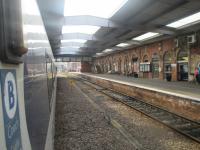
Grimsby Town: UK Railtours' return excursion from Cleethorpes to London St. Pancras passing Grimsby Town station, on the evening of Saturday, 7th May 2016. This station was opened by the Manchester, Sheffield & Lincolnshire Railway, on 29th February 1848.
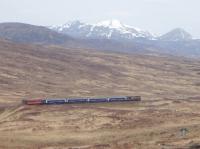
Corrour Summit: 0859 on 7th May 2016 and the northbound sleeper departs from Corrour and runs past the Grey Corries behind a Class 67 heading for the next stop at Tulloch and Fort William. Photo by Mark Edwards.
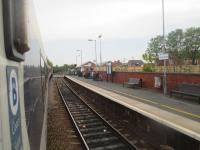
Newark Castle: UK Railtours' return excursion from Cleethorpes to London St. Pancras passing Newark Castle station, having just negotiated the level crossing with the East Coast Main Line, on the evening of Saturday, 7th May 2016. This station was opened by the Midland Railway on 3rd August 1846.
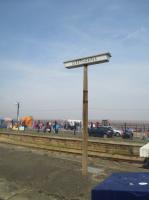
Cleethorpes: In early BR days, the Eastern Region, as well as adorning their stations with running-in boards and totem signs, were fond of putting station names on lamps. Most have now disappeared but here is one that survives at Cleethorpes station, seen here on Saturday, 7th May 2016.
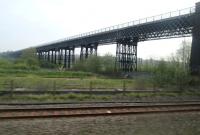
Bennerley Viaduct: The disused Bennerley Viaduct across the Erewash Valley, looking towards Nottingham from a UK Railtours excursion making its roundabout way from St. Pancras to Cleethorpes, on 7th May 2016. This viaduct was on the GNR line from Nottingham to Derby Friargate and was begun in May 1876 and completed in January 1878. The line closed, along with Derby Friargate station, on 7th September 1964 and although the viaduct is now a Grade II Listed Structure by English Heritage, it is also on their at risk list, due to its current poor condition. It was recently visited by Tim Dunn in one of his excellent The Architecture the Railways Built t.v. programmes where he spoke to a member of The Friends of Bennerley Viaduct who are doing their best to restore it as much as possible but, for the time being, it remains unwalkable.
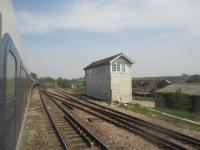
Barnetby: Barnetby East signal box, seen from UK Railtours' excursion from St. Pancras to Cleethorpes, passing on 7th May 2016.
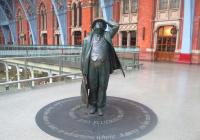
St Pancras: The statue of former Poet Laureate Sir John Betjeman (1906 - 1984), a BIG hero of mine for his love of London and its stations and railways in general, plus his evocative poetry, who valiantly tried but failed to save the original Euston station of 1837 from the bulldozers (a case of legalised vandalism if ever there was) but who was, thankfully, more successful in saving St. Pancras station from suffering the same fate. Seen here on the concourse of the station he rescued, on 7th May 2016. The statue is by British sculptor Martin Jennings and was unveiled in November 2007 when the station reopened as the Eurostar Channel Tunnel terminus. Mr. Jennings also designed the statue of poet Philip Larkin unveiled at Hull Paragon station in 2010.
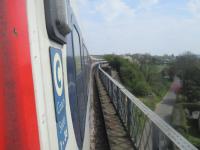
Brookhouse Viaduct: Between Shireoaks, on the Sheffield to Lincoln line in Nottinghamshire, and Kirk Sandall on the Doncaster to Cleethorpes line in Lincolnshire, runs the little-known and quite secretive freight line of the former South Yorkshire Joint Railway. Authorised in 1903, it opened to freight on 1st January 1909 and to passengers on 1st December 1910 but the passenger service lasted only 19 years, ceasing on 2nd December 1929. It does, however, remain as a freight route for coal transportation to both the Trent and Aire Valley power stations. On 7th May 2016 it re-awakened to the sound of a passenger train again when a UK Railtours excursion from St. Pancras to Cleethorpes traversed the line, seen here crossing Brookhouse Viaduct, the line's most substantial engineering feature.
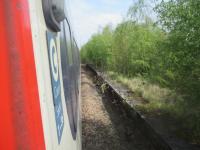
Maltby: UK Railtours excursion from St. Pancras to Cleethorpes, on the ex-South Yorkshire Joint Railway freight only line between Shireoaks and Kirk Sandall, passing the remains of Maltby station on 7th May 2016. This opened on 1st December 1910 and closed as long ago as 2nd December 1929 when the passenger service on the line was withdrawn. The line has stayed open for coal traffic to both the Trent and Aire Valley power stations.
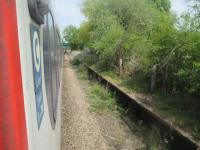
Tickhill and Wadworth: Tickhill & Wadworth station on the South Yorkshire Joint Railway opened on 1st December 1910 and closed on 2nd December 1929 when passenger services were withdrawn after just 19 years and long before Beeching was ever heard of. However, the line remains open for coal transportation to both the Trent and Aire Valley power stations. Despite many years of closure, the station remains are still there (as are those at Maltby) and seen here from a UK Railtours excursion from St. Pancras to Cleethorpes that traversed the line on Saturday, 7th May 2016.
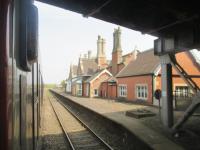
Brocklesby: The closed station at Brocklesby, Lincolnshire, being passed by UK Railtours excursion from London St. Pancras to Cleethorpes on 7th May 2016. This station was opened by the Great Grimsby & Sheffield Junction Railway on 1st March 1848 and was closed on 3rd October 1993 at a time when rail and station closures were less enthusiastically pursued than in the devastating Beeching era. The station is situated at the west end of the triangle leading onto the Barton-Upon-Humber branch to which trains now only enter or leave via the eastern side running to and from Grimsby and Cleethorpes. The building is in a Mock Tudor style, designed with private rooms for the Company's directors and shareholders and is a Grade II Listed Building by English Heritage, despite the fact passengers last trod on its platforms more than a quarter of a century ago.
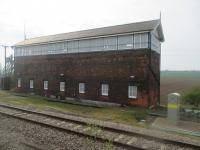
Barnetby: Barnetby West signal box, isolated in the Lincolnshire flatlands, seen from UK Railtours' return excursion from Cleethorpes to St. Pancras, on 7th May 2016.
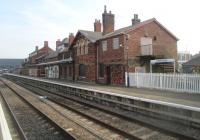
Cleethorpes: Cleethorpes station, Lincolnshire, on 7th May 2016. This station was opened by the Manchester, Sheffield & Lincoln Railway on Easter Monday, 6th April 1863. These buildings, however, date from 1884.
See query 2245
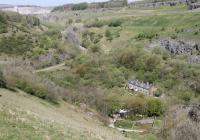
Blackwell Mill: Panoramic view of the old triangle at Blackwell Mill, taken from the lay-by on the A6 road that runs high above this point. Top left is the Great Rocks quarry complex and the surviving line from there to Buxton curves north to west. The old main line runs behind the railway cottages down to Millers Dale while the west to east chord is at the foot of the picture, now part of the Monsal cycling trail. It is on this chord that Blackwell Mill Halt, claimed for many years to be the smallest station in Britain, is situated but just out of view. The Disused Stations website advises that the two short platforms are still in situ and has pictures of the halt when open.
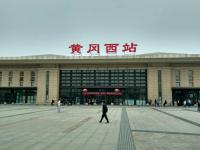
Huanggang West Station: Huanggang West Station. This is a relatively new provincial high speed line in Hubei between the provincial capital Wuhan and the city of Huangang - terminating at Huanggang East. There are several intermediate stations on the line and line speed appears to be 200km/h. Journey time is around 35 minutes depending on stops. There is an hourly 8 car service in each direction using CRH2 stock. Wuhan's urban population is around 6.5million but over 9 million if suburban areas are included. Huanggang's urban population is around 400,000 but the surrounding area totals around 6 million.
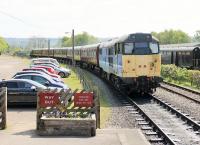
Rowsley: Regional Railways liveried Brush Type 2 31270 slows for the Rowsley stop with a service from Matlock on 7th May 2017. The Class 31 was working top and tail with an industrial 0-6-0T.
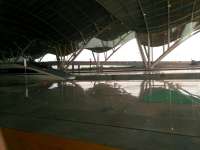
Wuhan: Departing Wuhan station on board train D3004, the 12.51 Wuhan to Shanghai Hongqiao, consisting of CRH1 stock passing a CRH380A train at rest on another platform. 7 May 2017. D3004 is a intercity stopping service and takes a less direct route to Hefei and thence onto Nanjing and Shanghai. The line speed for the high speed sections between Wuhan and Nanjing appears to be 250km/h.

Newbattle Viaduct: All roads lead to Gorebridge. The Lothian no 29 bus ex-Silverknowes has just turned off the A7 heading for Main Street, Newtongrange on the morning of 7 May 2017. In the background, the ScotRail 1011 ex Waverley has appeared at the north end of Newbattle Viaduct. The bus will terminate at Gorebridge, while the train will call there on its way to Tweedbank.
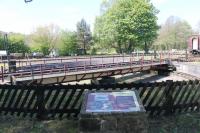
Rowsley [2nd]: The Peak Rail turntable at Rowsley Shed came from Mold Junction but has been installed in the excavated pit of the original turntable and is fully operational. 7th May 2017.

West Kensington: LU S7 stock with a District Line service to Ealing Broadway arriving at West Kensington station on 7th May 2017. This station was opened by the MDR as North End (Fulham) in 1874 and renamed West Kensington in 1877.
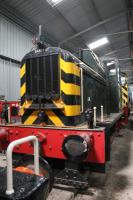
Rowsley [2nd]: Another Heritage Shunters Trust locomotive, pictured in the confined Rowsley shed in May 2017. This is Barclay Class 01 D2953, a 153hp DM 0-4-0 from 1956. It is reputedly the first BR Diesel locomotive to be sold into industry, going to Thames Matex in Essex in 1966. It has been preserved since 1985. Behind is another small 0-4-0, Class 02 D2854, which is only four years younger but arguably more stylish and also very practical with its big windows and veranda cab entrance.
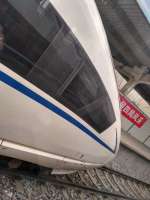
Lu'an: Deliberately angled grab shot of the front end of a CRH380C unit at Lu'an, Anhui Province taken from train D3004 during its station stop there on route to Hefei, Nanjing and Shanghai. 7 May 2017
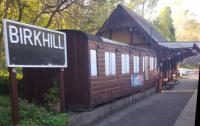
Birkhill: Nice lamps and signal posts in place.
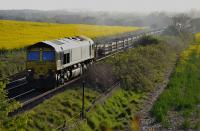
Inverkeithing East Junction: Freightliner 66529 climbs away from Inverkeithing East Junction with a Millerhill - Huntly rail train on 7 May. 66507 was on the rear.
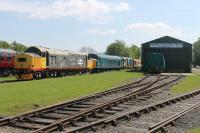
Rowsley: Preserved diesels 37152 and 46035 stand in the Peak Railway sidings at Rowsley alongside the Heritage Shunters Trust stock shed. The Trust has examples of Classes 01, 02, 03, 04, 05, 06, 07, 08, 09 and 14 at Rowsley - a remarkable collection that is well worth a visit, if a little difficult to photograph in cramped surroundings but at least most are now under cover.

Rowsley: Heavily stripped 58022 was moved from Crewe to Rowsley in 2016 and it is planned to further reduce it to form the basic frame of the Project Icon re-creation of LMS 10000. For now the loco sits in a siding at Rowsley awaiting developments. The Trust already has a suitable EE engine and bogies for this new build project.

Rowsley: Sole surviving Barclay Class 06 0-4-0 shunter has led a varied life and also been based at a number of preservation locations See image [[37009]]. Now in the care of the Heritage Shunters Trust at the Peak Railway it was tucked away at the back of their workshop in May 2017 undergoing a full overhaul. Restoration was completed during 2019. Footnote: No, I don't know why the duck is there either.
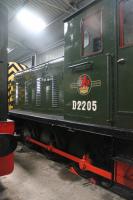
Rowsley [2nd]: The Heritage Shunter Trust has a splendid collection of ex-BR locomotives at Rowsley, many of which are kept under cover in their shed. Getting the maximum numbers inside means there isn't much room for photography but here is most of the beautifully restored D2205 from the first batch of Class 04s, being one of only three of those to survive. It spent much of its working life around the North East and was in very poor condition before its restoration. Later 04s had larger wheels and improved cabs and the Trust has four of those in its collection.
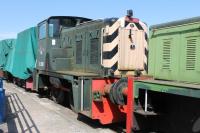
Rowsley [2nd]: Yorkshire Engine Co. 0-4-0 Class 02 D2868, seen at the Heritage Shunter Trust base at Rowsley in May 2017. This small diesel hydraulic was only in BR service from 1961 to 1969 and spent the last five years at Lostock Hall, followed by thirteen years in industry before preservation.
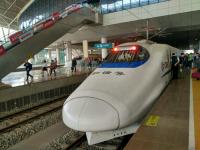
Wuhan: Wuhan railway station. Train C5606 consisting of CRH2 stock has just arrived from Huanggang. The C-train could probably be described as a provincial inter-city train. A comparable service in Scotland might use a 158 or 170 ... well, there's no comparison really ...! Wuhan station opened in 2009 with the opening of the Nanjing-Hefei-Wuhan high speed line. 7 May 2017.

Glasgow Queen Street High Level: A 2 coach class 156 DMU sitting at the end of the newly extended platform 1 which was brought in to use over the May holiday weekend. The platform will now accommodate 2x 2 coach trains or a single 4 coach unit.
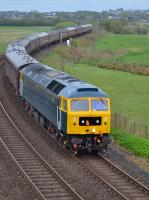
Lumphinnans Central Junction: North East Railtours excursion from Newcastle to Inverness passes the former Lumphinnans Central Junction on 7th May 2018. This leg was led by GBRf 47727 (a recent acquisition from Colas) and tailed by 66728.
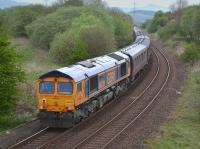
Lumphinnans Central Junction: GBRf 66728 Institution of Railway Operators brings up the rear of a North East Railtours excursion from Newcastle to Inverness as it passes the former Lumphinnans Central Junction. GBRf 47727 was hauling this leg of the tour. 7th May 2018.
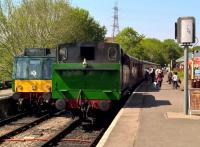
Bitton: Something of a contrast in styling between the rounded off DMU on the left, and the Polish steam locomotive on the right, which took us to Avon Riverside and back in May 2018.
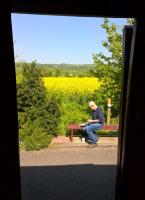
Avon Riverside: Pre-packaged countryside: looking North through an open door between Bristol and Bath on the Avon Valley Railway.
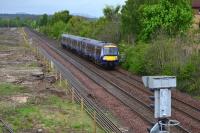
Perth New Yard: 170428 forming the 08.44 from Inverness to Glasgow Queen Street passes the former Perth New Yard. New rails have been set out to create the new facility.
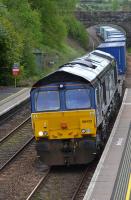
Gleneagles: DRS 66433 enters Gleneagles with the daily Grangemouth - Aberdeen intermodal on 7th May 2019.
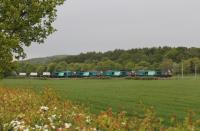
Woodacre Crossing: Four locos on the flasks. 68017 Hornet, 68004 Rapid, 68003 Astute and 68016 Fearless at Woodacre with the evening train from Sellafield to Crewe on 7th May 2019.
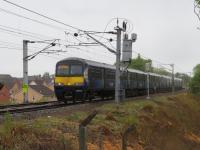
Whifflet: 320313 leads a Cumbernauld to Dalmuir service on the Caledonian main line between Coatbridge Jct and Whifflet on 7th May 2019.
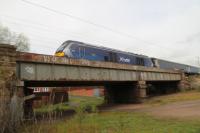
Dundyvan Junction: 68007 on the Caledonian main line between Coatbridge Jct and Whifflet with the morning empty coaching movement from EdinburghWaverley to Motherwell on 7th May 2019. The bridge at Dundyvan was required as the Souterhouse Branch ran underneath. This was the line from Whifflet Yard to the British Tube Works and Dundyvan Iron and Steel Works.
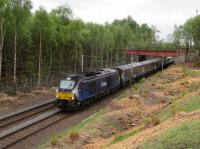
Whifflet Lower: Amazing what you can see after the tree removal team have been! 68006 takes the afternoon empty coaching movement from Motherwell and Edinburgh Waverley north from the former Whifflet Lower station under what was Whifflet Upper Station. Access to the former upper station has been blocked off. 7th May 2019.
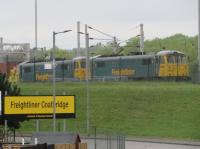
Coatbridge Freightliner Terminal: 86605 and sister loco await departure for London Gateway.
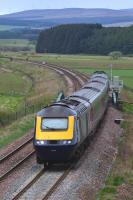
Blackford: 43149 leads a Glasgow Queen Street - Aberdeen Inter7City service towards Blackford, seen from Panholes footbridge on 7th May 2019.
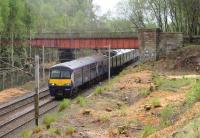
Whifflet Upper: 320411 seen shortly after leaving Whifflet on a Cumbernauld service on 7th May 2019. The EMU is passing below what was the overbridge of the Airdrie branch. Whifflet Upper station was an island platform built on the bridge and the platform is still visible. Viewing opportunities here have been considerably improved by the activities of the tree gangs.

Whifflet Yard: What was Whifflet Yard and is now Wfifflet Loop looking north. The yard, and Lochrin Iron Works, were on the far side of the railway. The sleepers in the foreground are the site of the north end of the sidings at the Whifflet NB station, with the site of the weigh bridge for the Souterhouse branch just a little to the north.
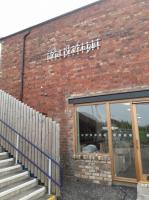
Dean Oil Works: The new bistro in the former Dean Oil Works at Newtongrange Station is being opened on 11 May by the Apex Trust.
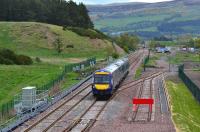
Blackford: 170412 on the 10.43 from Aberdeen to Glasgow Queen Street passes the new connection into Blackford Freight Terminal, still under construction.
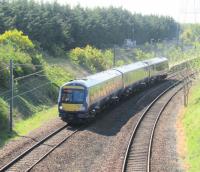
Brunstane: A Tweedbank to Waverley service leaves its last stop behind on 7th May 2020. It looks like the (bidirectional) lines are going their separate ways here but they will converge behind me then join just before reaching the ECML. Photographed incidental to my daily exercise permitted under emergency coronavirus legislation.
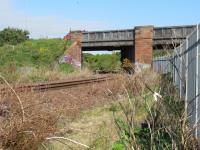
Meadows Box [2nd]: I am standing at the exact location of Meadows Box and looking along the moribund South Leith Branch towards Leith. Craigentinny Meadows became smothered in suburbia (and a railway yard) and the name died out; this location is now part of Seafield. Photographed incidental to my daily exercise permitted under emergency coronavirus legislation.
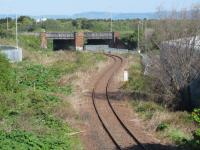
Meadows Junction: A look east along the South Leith Branch to the point where it went under Seafield Road at the location of Meadows box. Meadows Junction was in the foreground. Should the line be closed for good it is quite possible that the bridge will go and the road realigned to iron out the double bend the bridge causes. Photographed incidental to my daily exercise permitted under emergency coronavirus legislation.
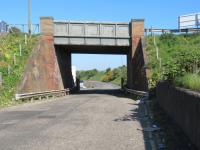
Craigentinny Meadows Box: The out of use South Leith Branch runs under Fillyside Road slightly further south, but the original line took a more direct course and ran under this bridge. Meadows Yard bulged between the two lines behind me. What looks like a road ahead is in fact the car park of a strangely located fashion outlet. Photographed incidental to my daily exercise permitted under emergency coronavirus legislation.
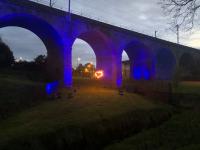
Coatdyke Viaduct: Coatdyke viaduct in Coatbridge, was lit-up blue to show solidarity with key workers and frontline NHS staff all across the country. The viaduct, east of Coatdyke station in Coatbridge, North Lanarkshire, joined with other Network Rail stations and structures across the UK in lighting up in NHS colours to salute the continued dedication and efforts of healthcare workers in the battle against the coronavirus. The ten-span brick viaduct dates from 1861 and, as well as being an impressive structure in itself and a suitable backdrop to ‘Light-up’, is next to University Hospital Monklands, which houses one of Scotland's four regional infectious diseases units and is at the centre of the struggle to save lives during the pandemic. The illumination of the North Lanarkshire structure comes as people throughout the country once again join in a mass round of applause at 8pm on Thursday to thank NHS staff for their incredible work.
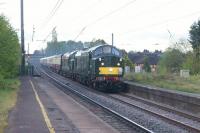
Leyland: The early photographer catches the 37s. 37521 and 37667 (aka D6817 and D6851) head north at Leyland with the 5Z37 Crewe to Corbridge stock move, later forming the 1Z37 from Corbridge to Elgin via Dundee and Aberdeen. The train travels to Thurso in the early hours of Saturday. The Orcadian headboard perhaps giving a clue as to the passengers destination.
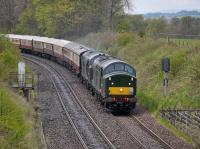
Donibristle Platform: Locomotive Services Ltd's 37521 and 37667 (which as D6851 worked the last northbound freight over the Waverley Route) climb Donibristle bank with a private charter to Elgin, and ultimately Thurso, on 7 May 2021.
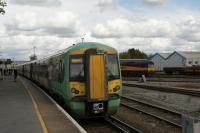
Eastleigh: A splash of green at Eastleigh as Southern Railway 377122 arrives with the daily trip from Brighton to Eastleigh and return on 6th May 2021. This service has its roots in the old Parliamentaries of the Victorian era.
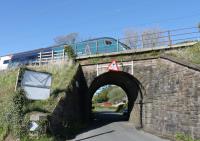
Bay Horse: The low bridge on Hollins Lane, between Forton and Bay Horse, is one of around fifteen similar structures between Lancaster and Preston. Often with an angled approach, eight of them still cross public roads requiring caution from motorists and other users. 390128 crosses heading from Glasgow to Euston on 7th May 2021.
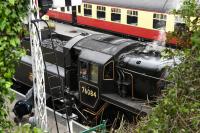
Sheringham (North Norfolk): Two youngsters enjoy a visit to the cab of Standard 4MT 2-6-0 76084, in between North Norfolk services, at Sheringham on 7th May 2022.
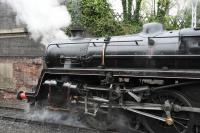
Sheringham (North Norfolk): During a flying visit to the North Norfolk Railway, on 7th May 2022, I managed to see their British Railways Standard 4MT 2-6-0 76084 in steam. This is the ex-Barry loco that sat in a man's garden for many years before finally, after he died, being rescued and restored to good health and main line condition.

Stavanger: An NSB Class 72 4-car EMU approaches Stavanger, through the cutting at the station approach, in May 2022. These trains were first introduced in 2002, styled by Pininfarina. The line to Stavanger was narrow gauge until the 1940s German occupation when it was converted to standard width. A disused goods branch runs from Stavanger station through a tunnel to the harbour. (With thanks to Stewart Duthie for additional local information).

Sheringham (North Norfolk): The tender of BR 4MT 76084 is filled to overflowing at Sheringham on 7th May 2022.
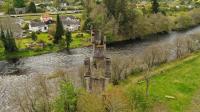
Oich Viaduct: The piers of the Oich Viaduct in Fort Augustus. The viaduct was on a gentle curve as it carried the railway towards the pier on Loch Ness. This part of the line closed after just three years.
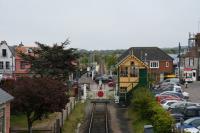
Sheringham (North Norfolk): For half a century or so from the 1960s the North Norfolk Railway was isolated from Network Rail by around 100 yards. Sometime around 2010 the two lines were reconnected allowing occasional special trains and light engines to access the NNR. A May 2022 view from the NNR station footbridge showing the new level crossing, the signal box and the main line station beyond.
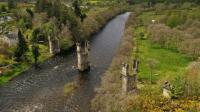
Oich Viaduct: The piers of the viaduct that carried the railway over the River Oich at Fort Augustus. This was an extension from Fort Augustus station to a pier station at the side of Loch Ness. This extra mile was the most expensive part of the line, involving a swing bridge over the canal, two road bridges and this viaduct. This part of the line could have been part of the through route to Inverness that was projected but it wasn't completed and the pier line closed after only three years.
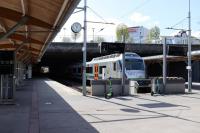
Stavanger: Bergen and Stavanger are both stations on the Norwegian west coast but while Bergen is a splendid old station with an overall roof [[35106]] Stavanger has a modern office block and the gloomy platforms lie under a concrete car park. This view from the buffers on 7th May 2022 shows an NSB Class 72 EMU in one of the platforms. These units have 'pininfarina' logos on the sides of the driving coaches.
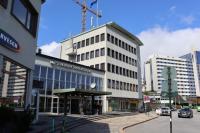
Stavanger: The rail terminus at Stavanger in May 2022. There are worse station buildings around but it cannot compare with that at Bergen, further north on the west coast, for style and grandeur.
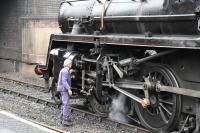
Sheringham (North Norfolk): Oiling round 76084 at Sheringham on the the North Norfolk Railway on 7th May 2022. This photo nicely illustrates just how high the running plate is on the BR Standard 4MT 2-6-0.
Events
Events from the chronology which occured on this day. This generally lists events before 1995, the creation of the website.
News
These are old news items which which occured on this day. This generally lists events after 1995, the creation of the website.
| Year | Companies | Description |
|---|---|---|
| 2003 | Scottish Power contract with Clydeport | A contract between Scottish Power and Clydeport may help re-open the Stirling-Alloa-Kincardine line to freight carrying coal from Hunterston terminal to Longannet Power station. |
| 2008 | Rail plans going at full tilt [Scotsman] | NEW carriages for tilting trains to ease overcrowding on the Glasgow-London west coast main line by 2012 have been ordered by ministers. |
| 2008 | City chiefs hear tram-train plan for Edinburgh sub [Evening News] | TRAM-TRAINS would run on Edinburgh^s South Suburban rail line under plans to be considered by city leaders. Officials have been asked to carry out a study into the possibility of running the hybrid trams from Newcraighall to Haymarket, where they would transfer to the city^s new tram line out to Edinburgh Park. |
| 2009 | National Express wants taxpayers cash to keep running ECML trains [The Times] | Britain’s most lucrative train franchise is on the brink of failure, leaving the Government facing a £1 billion hole in its rail budget.[From Mark Bartlett] |
| 2009 | MSP challenges rail bosses to try out ^crush hour^ [Dunfermline Press] | RAIL bosses have accepted a challenge to see first-hand what West Fife commuters put up with in the “crush hour” between Dunfermline and Edinburgh |
| 2010 | NR on track to prevent cable theft [Network Rail] | Network Rail is to deploy new technology to help fight one of the biggest causes of disruption to train services - the theft of railway cables. |
| 2011 | Rail union fears of job cuts and fare rises grows [Scotsman] | Union leaders have warned that a government study into the railway industry threatens safety and could lead to cuts in train services. |
| 2013 | National Railway Museum looks to improve food facilities for visitors [The Press] | THE National Railway Museum in York is planning to use shipping containers to improve its food facilities for visitors. The huge cargo-holders will be stacked in the south-east garden of the museum, if proposals are approved by City of York Council. The museum wants to construct, adapt and refurbish the containers so they can operate as an outdoor pizza service and ice-cream kiosk, complete with sliding doors. Its management also hopes to move its old-style Valiant railway carriage to the garden area so it can become a Victorian tearoom. [From Richard Buckby] |
| 2014 | Driver Killed As Train Hits Car On Crossing [Sky News] | A man has died after his car was hit by a rush-hour train on a rail crossing in North Yorkshire. The crash near the village of Rillington, near Malton, involved a First TransPennine Express train, which was travelling from Scarborough to Liverpool Lime Street at the time. |
| 2015 | Harry Potter line steam train service hits buffers [Scotsman] | THE operator of the Jacobite steam train on the Fort William-Mallaig line admitted today it was unlikely to launch services next week as planned after being banned from the rail network. West Coast Railways (WCR), which carries 85,000 tourists a year on the route, was barred by Network Rail last month from operating across Britain after causing the worst case of running through a red light this year. |
| 2015 | Thameslink testing and stabling [Rail Engineer] | The Thameslink programme is going well. A complex project to upgrade the existing route through the centre of London while also adding new London Bridge, disruption was always bound to occur but, by 2018, it will be complete and a staggering 24 trains per hour each way will be running on a twin-track railway through the centre of London. The £6.5 billion project will see the original destinations of Bedford and Brighton augmented by Peterborough and Cambridge, from whence trains will run through the Canal Tunnels, joining the ‘traditional’ Thameslink route just north of the St Pancras platforms. At the southern end of the route, trains will terminate at Tattenham Corner, Horsham, Caterham, East Grinstead Sevenoaks and Maidstone in addition to Brighton. All trains will call at St Pancras, Farringdon, City Thameslink and Blackfriars. The latter station has already been completely rebuilt to span the Thames. Many services will also stop at London Bridge, which is currently getting a makeover. The work required is extensive and long-suffering commuters are having to cope with an ever-changing situation. However, once complete, Thameslink’s services will have a dedicated path through the busy station for the first time ever. [From Richard Buckby] |
| 2015 | Borders Railway could set example [Scotsman] | IT HAS been hailed for its major tourist potential and will be the longest new line in Scotland for a century, but the Borders Railway also threatens to become a classic example of how not to build a railway. The re-opening of a 30-mile section of the historic Waverley route between Edinburgh and Carlisle was a leap of faith when conceived more than a decade ago – as it will serve a relatively sparsely populated area. [From David Spaven] |
| 2016 | Flying Scotsman to travel in secret [The Press] | Details of Flying Scotsman^s journeys on the national railway network are being kept secret for safety reasons. Neither the National Railway Museum, which owns the iconic locomotive on behalf of the nation, and Network Rail, responsible for the railway infrastructure, will say where and when she will be. British Transport Police have warned they are prepared to prosecute anyone who goes on the railway tracks to get a better view of her. The decision to withhold her timetable from the public follows scenes on her return to the main line in February after a ten-year refit when people including young children risked their lives by standing on the railway line to get a better view. [From Richard Buckby] |
| 2017 | Railway needs to raise £5,000 to continue venture [Cambrian News] | MEIRIONNYDDS latest heritage railway venture are looking to secure thousands of pounds in investment to continue with their venture. The Blaenau Ffestiniog and Trawsfynydd Railway is on track to receive £2,500 from the Heritage Lottery Fund - but only if they can raise £5,000 themselves first. The BFT Railway Society is aiming to restore a seven-mile section of mothballed railway in north Wales. The line has been left dormant since the last train ran in 1998 on decommissioning work, for the nuclear power plant in Trawsfynydd. |
| 2018 | Britain^s ^best and worst^ railway stations named [BBC News] | The most popular and unpopular stations in Britain are revealed in a transport watchdog^s survey. |
| 2018 | Glasgow Queen Street named most unpopular station in UK [Scotsman] | Glasgow Queen Street has been given an unwanted accolade after frustrated commuters named it Britains most unpopular railway station. |
| 2018 | ScotRail under fire over performance failings [BBC News] | After a weekend of disruption for passengers at Glasgow^s Central Station, it has emerged ScotRail missed most of its latest performance targets. Damage to overhead lines saw passengers stranded on trains for several hours on Saturday as dozens of services were cancelled and the station was closed. It has now emerged ScotRail missed performance targets in 22 out of 34 areas in the first months of 2018. The company said it would keep improving its level of service |
| 2018 | ScotRail hit with record fine after performance failures [Scotsman] | Scotland^s national train operator ScotRail is facing record fines totalling £1.6 million over shortcomings in services for passengers. |
| 2019 | Historic footbridge successfully installed at Stirling station [Network Rail] | Network Rail successfully re-installed the footbridge linking platforms six and nine at Stirling station this holiday weekend. |
| 2019 | Residents warn that a car ban on the Mull-Lochaline ferry will have a devastating effect on islanders [Press and Journal] | Plans for a car ban on a lifeline island ferry service will have a devastating impact on businesses, commuters, tourists and parents, it has been claimed. |
| 2020 | Blaenau Ffestiniog tunnel lighting up blue for NHS and all critical workers [Network Rail] | Network Rail is lighting up the Blaenau Ffestiniog tunnel tonight (7 May) from 20:00hrs in honour and gratitude to all NHS staff and other workers who are battling the coronavirus crisis. |
| 2020 | Scottish passengers most comfortable in Britain to get back on buses and trains [Scotsman] | Scots would be the happiest in Britain to travel by bus and train again after lockdown restrictions are eased, a survey for official passenger watchdog Transport Focus showed today. |
| 2020 | Scotland^s Railway marks 75th Anniversary of VE Day [Network Rail] | Scotland^s biggest train stations will hold a series of events on Friday (May 8) to mark the 75th anniversary of the Allies^ Victory in Europe. |
| 2020 | Waggonway Museum Tour [YouTube] | 1722 Waggonway Project - bringing the Waggonway Museum to you during lockdown! |
